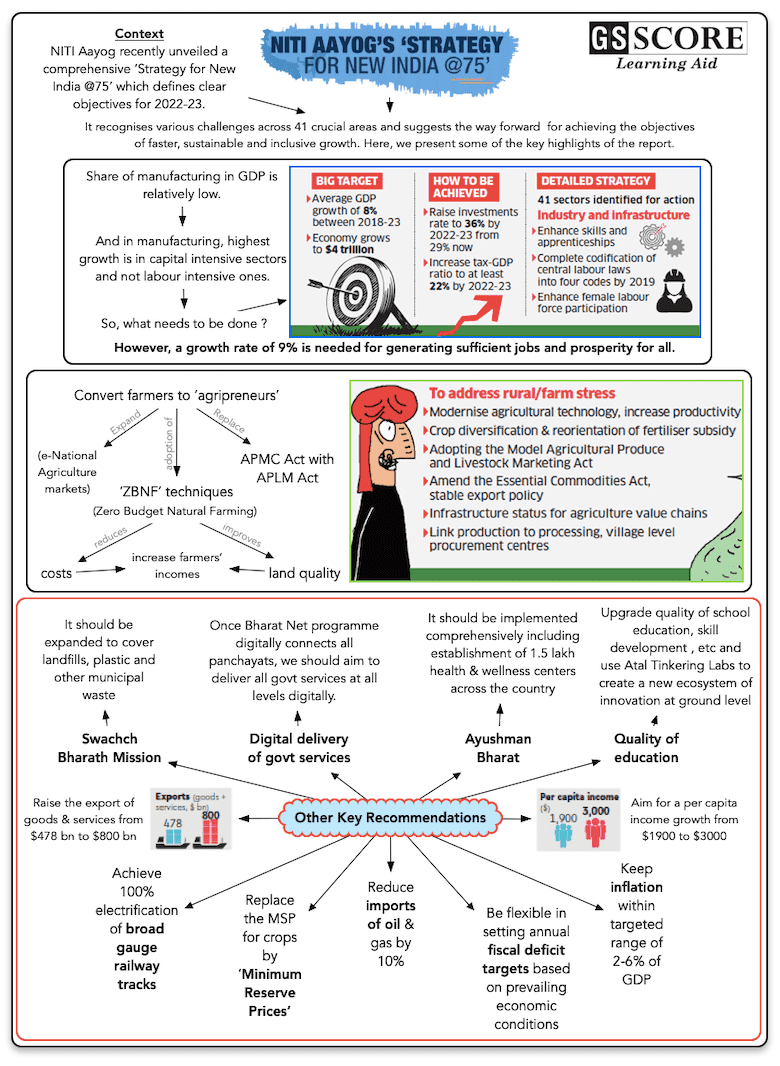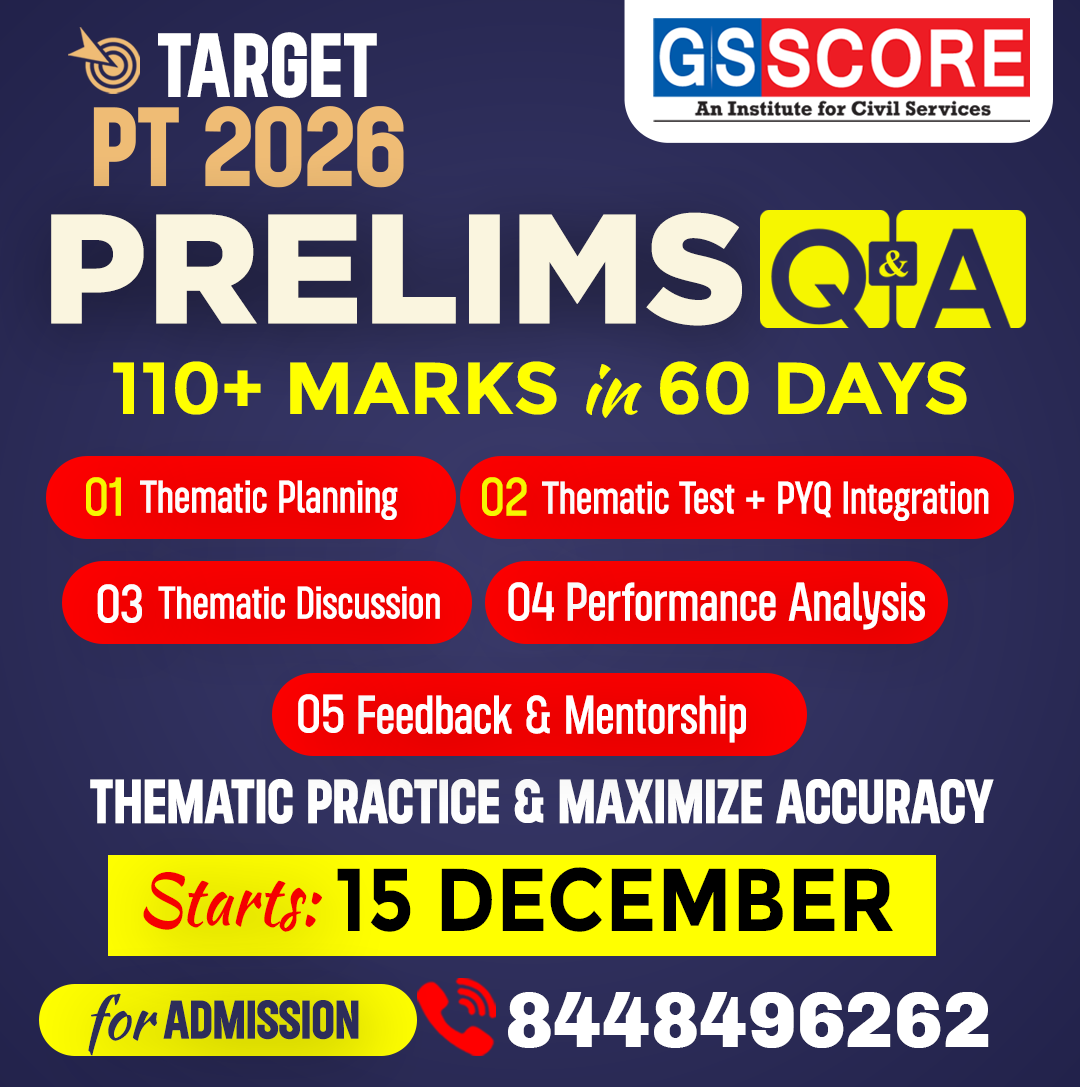

- The NITI Aayog recently unveiled its comprehensive National Strategy for New India @ 75, which defines clear objectives for 2022-23.
- It is a detailed exposition across forty-one crucial areas that recognize the progress already made, identifies binding constraints, and suggest way forward.
Issue
Context
- The NITI Aayog recently unveiled its comprehensive National Strategy for New India @ 75, which defines clear objectives for 2022-23.
- It is a detailed exposition across forty-one crucial areas that recognize the progress already made, identifies binding constraints, and suggest way forward.
About
Mission 2022-23 Vision document
- The Strategy for New India @75 put together by NITI Aayog is an attempt to bring innovation, technology, enterprise and efficient management together, at the core of policy formulation and implementation. It will encourage discussion and debate, and invite feedback for further refining country’s policy approach.
- The government believe that economic transformation cannot happen without public participation. Development must become a Jan Andolan.
- The forty-one chapters in the document have been merged under four sections - Drivers, Infrastructure, Inclusion and Governance.
- Over 800 stakeholders from within the government – central, state and district levels – and about 550 external experts were consulted during the preparation of the document.
Objective
The Strategy document aims to further improve the policy environment in which private investors and other stakeholders can contribute their fullest towards achieving the goals set out for New India 2022 and propels India towards a USD 5 trillion economy by 2030.
Analysis
Highlights of the Vision document
- The development strategy includes doubling of farmers’ income, boosting ‘Make in India’, upgrading the science, technology and innovation ecosystem, and promoting sectors like fin-tech and tourism.
- It prescribes reducing upper age limit to join the civil services to 27 years from the present 30 years for General Category candidates by 2022-23 in a phased manner and also to have one integrated exam for all civil services.
- It calls for successfully implementing the Ayushman Bharat programme including the establishment of 150000 health and wellness centres and rolling out Pradhan Mantri Jan Arogya Yojana.
- The document outlines the need for creating agripreneurs, which implies creation of agro-processing industry at a much faster pace to enhance farmer participation though agro processing.
- It calls for participation of Private Sector in Indian Railways. From ownership of locomotives and rolling stocks to modernising stations, improvement of the railways hinges on private participation.
- It boasts of expanding the scope of Swachh Bharat Mission to cover initiatives for landfills, plastic waste and municipal waste and generating wealth from waste.
- The government will have to ease the tax compliance burden and eliminate direct interface between taxpayers and tax officials using technology.
- It suggests better compensation to banking correspondents, facilitating paperless banking and introducing financial literacy chapters in school curricula to spur financial inclusion.
- It recommends identification of the poorest among the minority communities through the socio-economic caste census data for proper targeting of various schemes.
Significant recommendations under different sections
Drivers: It focuses on the engines of economic performance with chapters on growth and employment, doubling of farmers’ incomes; upgrading the science, technology and innovation eco-system; and promoting sunrise sectors like fin-tech and tourism.
- Steadily accelerate the economy to achieve a GDP growth rate of about 8% on average during 2018-23. This will raise the economy’s size in real terms from USD 2.7trillion in 2017-18 to nearly USD 4 trillion by 2022-23. Increase the investment rate as measured by gross fixed capital formation (GFCF) from the present 29% to 36% of GDP by 2022.
- In agriculture, shift the emphasis to converting farmers to ‘Agripreneurs’ by further expanding e-National Agriculture Markets and replacing the Agricultural Produce Marketing Committee Act with the Agricultural Produce and Livestock Marketing Act.
- Give a strong push to ‘Zero Budget Natural Farming’ techniques that reduce costs, improve land quality and increase farmers’ incomes. This has emerged as a tested method for putting environment carbon back into the land.
- To ensure maximum employment creation, complete codification of labour laws and a massive effort must be made to upscale and expand apprenticeships.
- Launch a mission “Explore in India” by revamping minerals exploration and licensing policy.
Infrastructure: It deals with the physical foundations of growth which are crucial to enhancing the competitiveness of Indian business as also ensuring the citizens’ ease of living.
- Expedite the establishment of the Rail Development Authority (RDA), which is already approved. RDA will advise or make informed decisions on an integrated, transparent and dynamic pricing mechanism for the railways.
- Double the share of freight transported by coastal shipping and inland waterways. Initially, viability gap funding will be provided until the infrastructure is fully developed. Develop an IT-enabled platform for integrating different modes of transport and promoting multi-modal and digitized mobility.
- With the completion of the Bharat Net programme in 2019, all 2.5 lakh gram panchayats will be digitally connected. Aim to deliver all government services at the state, district, and gram panchayat level digitally by2022-23.
Inclusion: It deals with the urgent task of investing in the capabilities of all of India’s citizens. The three themes in this section revolve around the dimensions of health, education and mainstreaming of traditionally marginalized sections of the population.
- Successfully implementing the Ayushman Bharat programme including the establishment of 150,000 health and wellness centres across the country, and rolling out the Pradhan Mantri Jan Arogya Abhiyaan (PM-JAY).
- Create a focal point for public health at the central level with state counterparts. Promote integrative medicine curriculum.
- Upgrade the quality of the school education system and skills, including the creation of a new innovation ecosystem at the ground level by establishing at least 10,000 Atal Tinkering Labs by 2020.
- Conceptualize an electronic national educational registry for tracking each child’s learning outcomes.
- As already done in rural areas, give a huge push to affordable housing in urban areas to improve workers’ living conditions and ensure equity while providing a strong impetus to economic growth.
Governance: It delves deep into how the governance structures can be streamlined and processes optimized to achieve better developmental outcomes.
- Implement the recommendations of the Second Administrative Reforms Commission as a prelude to appointing a successor for designing reforms in the changing context of emerging technologies and growing complexity of the economy.
- Set up a new autonomous body, viz., the Arbitration Council of India to grade arbitral institutions and accredit arbitrators to make the arbitration process cost effective and speedy, and to pre-empt the need for court intervention.
- Address the backlog of pending cases - shift part of workload out of regular court system.
- Expand the scope of Swachh Bharat Mission to cover initiatives for landfills, plastic waste and municipal waste and generating wealth from waste.
Way Forward
- NITI Aayog CEO Amitabh Kant had said achieving a double-digit growth rate in the manufacturing sector on a sustainable basis was a "doable challenge" but the country needed to integrate with global markets for that.
- Modernisation of farming practices, employment generation and creating a conducive environment to attract private investments into the sector are the key to resolving the country’s agricultural issues.
- Further, the emphasis on reforms needs to be accompanied by social consciousness.
Learning Aid
Practice Question:
Discuss the significant recommendations of NITI Aayog’s vision document “Strategy for New India @ 75”.


